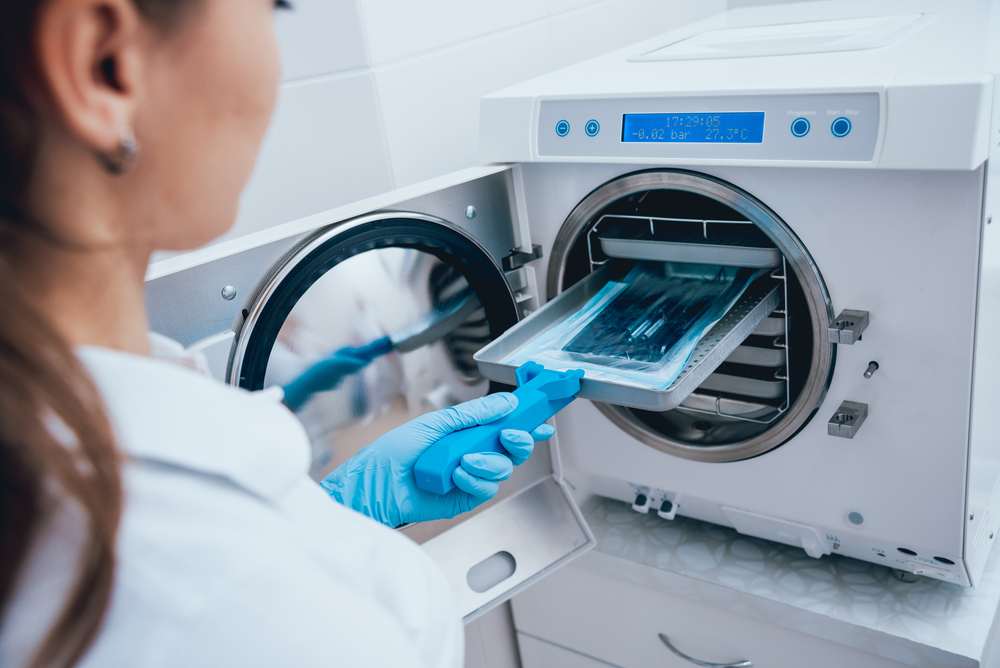In order to ensure labs and personnel remain as safe as possible, we have specific services in place. Specifically, handling biological specimens and hazardous materials present unique safety challenges. Services like lab equipment disposal, biosafety cabinet maintenance and certification are all keys to upholding cleanliness and safety.
In addition to these, procedures like lab equipment decontamination and sterilization also contribute to hygiene and safety. Sterilization is essential to keeping lab equipment, materials and samples clean and functional. In this post, we’ll discuss the five methods of lab sterilization that will keep you and your materials safe.
1. Wet Heat (Autoclaving)
Autoclaving is the most popular method of lab sterilization. This process uses pressurized steam to heat the item that requires sterilization. Autoclaving is an incredibly effective procedure. It will effectively kill all microbes, spores and viruses. However, for some specific biosafety levels, higher steam temperatures or longer incubation periods are necessary.
The steam generated from autoclaves contains seven times more heat than water at the same temperature. Additionally, when it contacts the material, it instantly delivers heat and can even penetrate a more dense, thick surface.
Autoclaving’s speed and efficiency at sterilizing materials is what makes it the most popular choice. Since these are vital to a lab’s daily operations, it is important to service and repair your autoclaves regularly.
2. Dry Heat (Baking or Flaming)
Dry heat sterilization is considered the most effective method for maintaining anything involving fats, oils, powders or materials more likely to rust. Essentially, the primary difference between dry heat and autoclaving is the absence of water or steam in dry heat sterilization. Some labs prefer dry heat to sterilize biosafety cabinets.
Basically, dry heat sterilization involves raising the temperature of an item to 325 degrees Fahrenheit or higher under normal air pressure. We use dry heat sterilization on a daily basis, and not just in lab settings. When we cook meat or poultry in an oven, we’re utilizing dry heat sterilization to remove the bacteria and microbes.
With dry heat, higher temperatures of heat are required to properly sterilize the item.
3. Filtration
Filtration is a method of lab sterilization that does not require heat. Additionally, it is the only method of sterilization that relies on force to separate microbes or bacteria in liquid rather than kill. Filters function by passing the liquid solution through a filter with pore diameters too small for microbes to move through. Essentially, the filter removes the organisms from the solution.
When it comes to proper sterilization, the filters used are usually membranous filters made from cellulose esters. In order to remove bacteria, they usually have an average pore diameter of 0.2um. However, if viruses or phage is a concern, filters are not a good technique for sterilization. These organisms can usually travel through even the finest of filters.
4. Chemicals/Solvents
Heating and filtration can be effective methods of sterilization and preventing contamination. However, in many cases the heat can damage the materials that need to be sterilized. This is where the uses of chemicals and solvents can come in handy.
While the chemicals used to sterilize are hazardous to humans, they won’t damage the items that must be sterilized. Even gases are solvents that can sterilize items. They provide swift sterilization by quickly penetrating the materials without the use of accelerated heat. In addition, they’re excellent for sanitizing high-traffic areas when they’re not currently populated.
Chemicals and solvents sterilize by denaturing proteins through procedures that require water. In order to be effective, they must be diluted by 60-90% in water.
Hydrogen peroxide, nitrogen dioxide and formaldehyde solutions are some of the most common chemical sterilizers. While these solvents are excellent at killing microbial cells, they have no effect on spores.
5. Radiation
Radiation use can make excellent techniques for lab sterilization. Ultraviolet light, x-rays and gamma rays are the kinds of electromagnetic radiation that swiftly pulverize DNA.
In air, UV has limited penetration capabilities. Basically, what this means is that the sterilization will only occur in a relatively small area directly within the lamp. However, it’s one of the more safe methods of sterilization. It’s often used in small areas such as laminar flow hoods.
Gamma and x-rays have excellent penetration capability. While this makes them inherently more dangerous, it also means they’re effective for sterilization on a much larger scale.
Conclusion
At S.E.P.S., we’ve made lab safety and hygiene our practice and our top priority. Lab equipment sterilization is absolutely essential to keeping labs safe and operational. Our various accreditations and affiliations are a testament to our enduring commitment to safety and hygiene. Some lab environments can present certain risks, and we make it our mission to eliminate them.
